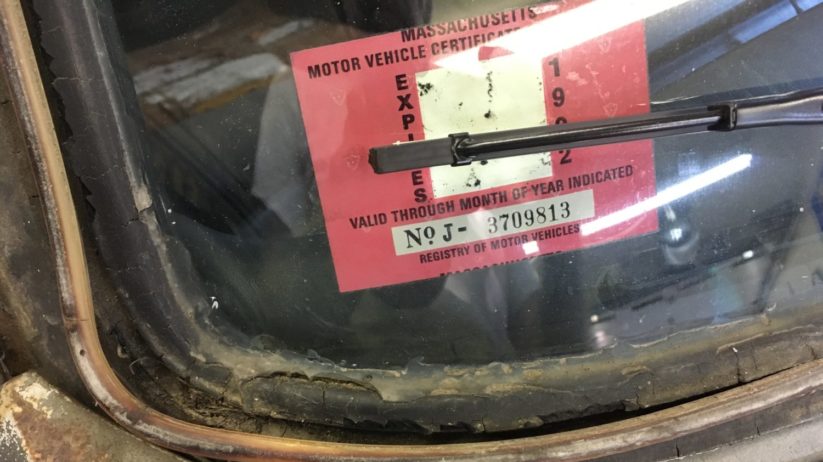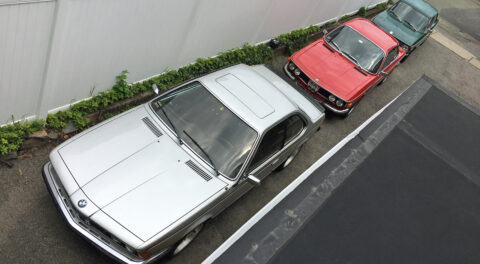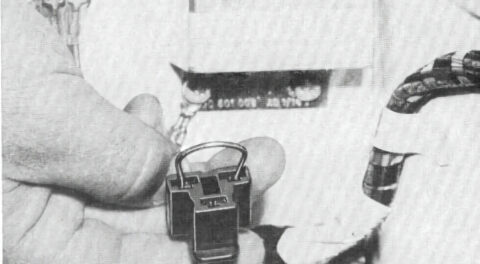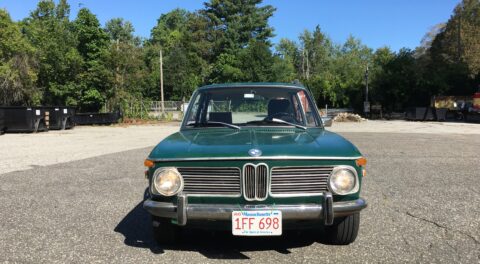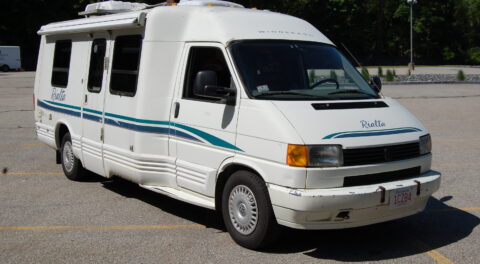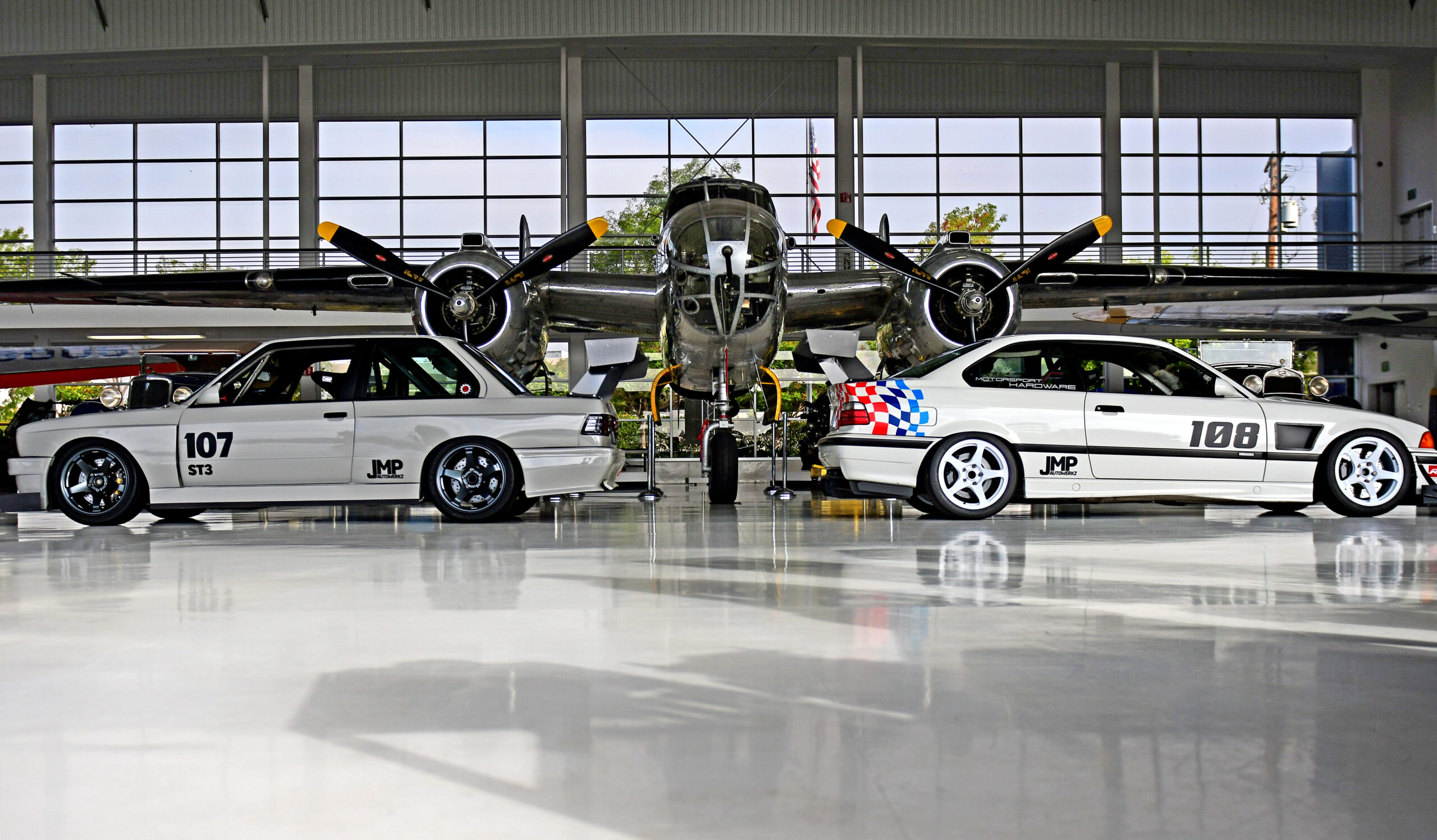Two weeks ago, I described sorting Bertha, my reclaimed 2002, to the point where around-the-block runs were sufficiently uneventful that I wanted to sail her farther from shore. I got the car registered, and had, as Jon Stewart used to say, my moment of Zen when I took her on an entrance ramp to I-95 and nailed the throttle. The dual Weber 40DCOEs opened up, and the car came on the Iskendarian 300-degree cam as she used to 30 years ago. Vroom, baby—Bertha was back!
It’s likely all downhill from there.
I kid—mostly. It was ironic that after this singular unburned-hydrocarbon-fuel automotive high, the next thing to deal with was the mundane but potentially show-stopping issue of inspection. And the clock was ticking, because in Massachusetts, you have seven days after registering a car to get it inspected. Driving a car with an expired inspection sticker is, in this state, a moving violation that adds points to your insurance. And the fact that Bertha looked the way she did, complete with an inspection sticker dated 1992 on the windshield, made her far from inconspicuous.
Motor-vehicle inspection in Massachusetts is probably second in stringency only to California’s. Every car, no matter how old, must undergo the annual $35 inspection; cars older than 2003 are exempt from emissions testing, but if an old car smokes visibly at idle, they can fail it. As I understand it, they’re not explicitly looking for the presence of year-correct emissions equipment (catalytic converter, smog pump, EGR plumbing, etc) the way they do in California, but if an excessively loud exhaust draws their attention—and if they find, for example, that the car is new enough that it should have a cat, but it’s not there—they can fail it. Rust is also an issue, as any hole in the body can be cause for failure on safety grounds, on the theory that it can potentially allow carbon monoxide into the car.
As you’re probably aware, Bertha is challenged on several of these fronts.
In addition to all of this, Massachusetts changed its inspection procedure last year to include five cameras in every inspection bay that record the process. If, when reviewed, there’s evidence that an inspector passed a car he or she shouldn’t have, the shop can lose its inspection license. This now causes inspectors to do things like jack up the front of the car and check the tie rods; this technically was already part of the inspection procedure, but was rarely done by anyone other than a particularly OCD inspector.

I didn’t think the inspector was going to miss seeing the crack.
With all of these potential inspection gotchas, Bertha’s immediate problem was actually quite straightforward: The windshield was plainly and visibly cracked right down the center from top to bottom. I knew that it needed to be replaced for the car to pass inspection, but I was hoping to avoid tangling with it so soon, because I knew it would be a royal pain in the butt. So, on a fact-finding trip, I stopped in at an inspection station (not my regular one, so I could play dumb), explained that I had a car with a cracked windshield, and asked if I could bring it in for inspection—and get a rejection sticker.
“Yes,” the man told me.
“And the rejection sticker gives me 90 days to get it fixed, right?”
“Yes,” the man repeated. This sounded like a perfect way to put off the windshield replacement until the fall. (As my brother-in-law recently said, “Much of getting older is simply buying time.”)
Unfortunately, it wasn’t true.
When I returned with the car, a more experienced inspector told me that you’re only given the 90-day period if the reason for rejection is emissions-related. For safety-related issues, the rejection sticker is a different color; there’s no grace period, and you can be stopped and fined at any time by a police officer if they see the sticker on the windshield.
Damn.
So I slid into get-the-windshield-done mode. I needed both a windshield and a gasket, as the gasket in the car was badly cracked and shrunken. 2002 windshield gaskets from Uro Parts are available for as low as $35, but they have a terrible reputation for fitting badly in the corners. OEM gaskets cost much more, but their use is strongly advised. With shipping, Roundel advertiser Bavarian Autosport came in at $128, and their OEM gasket arrived in a few days.
Obtaining the windshield was a remarkable example of reaping the benefits of pay-it-forward.
A few years ago, a couple, Jeremy and Corinne, borrowed my ’72 tii, Kugel, to drive away from their wedding (they’d originally hoped to use Jeremy’s 2002, but it was still disassembled and awaiting restoration). The wedding was in Narraganset, Rhode Island. A few days beforehand, Jeremy showed up at my house with a race trailer to transport Kugel. The wedding pics they sent me afterward were beautiful.
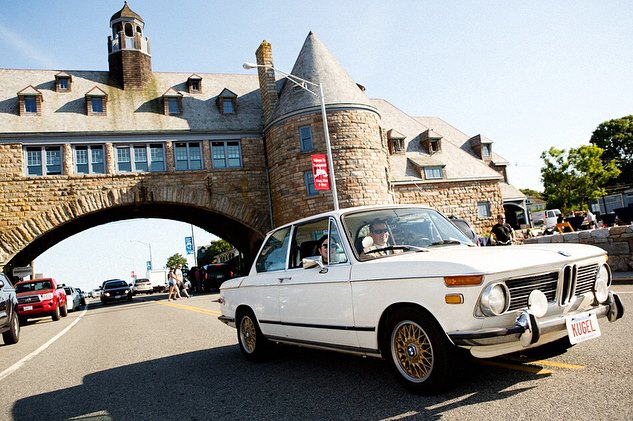
The pay-it-forward of loaning my ’72 tii to a grateful couple for their wedding got me a windshield.
So when I put the “2002 windshield needed” request out on Facebook and Corinne saw it, she forwarded it to Jeremy. He contacted me, saying that he had a windshield from a car he’d parted out years back, and that he could meet me halfway with it. Halfway from Rhode Island sounded fine.
A few days later, Jeremy e-mailed me saying that that evening would work for him, and that he’d be in New Rochelle at about 7:00 p.m. and could then head north from there. Wait, I thought, New Rochelle, as in Rob and Laura Petrie New Rochelle? I called Jeremy. “I thought we were talking about meeting halfway between Boston and Rhode Island,” I said. “What’s the deal with New Rochelle?”
Jeremy explained that I had it wrong: Their wedding was in Rhode Island, but they don’t live there; they’re down on Long Island. Jeremy was offering to drive from Long Island to deliver me a windshield. He was trying to combine it with a visit to his sister’s in New Rochelle.
Wow.
Once I understood the magnitude of his offer, I quickly looked at the map, saw that Hartford was about halfway for both of us, and began driving. We did the hand-off of the windshield in the parking lot of a Wendy’s off I-95. I said, “Gosh, I can’t thank you enough for driving all this way just to give me a windshield!”
“What are you talking about?” Jeremy said. “It’s the least we can do for you having loaned us your 02 for our wedding.” In addition to that, the idea that his spare windshield was going into Bertha, which was the car in which Maire Anne and I drove off from our wedding, was a remarkable bit of synergy.
With the windshield and gasket in hand, I set about the installation process. As I said, I expected it to be a pain, because I did the windshield last year in Louie, and it was very challenging repair for three distinct reasons, all of which I expected to come into play with Bertha.
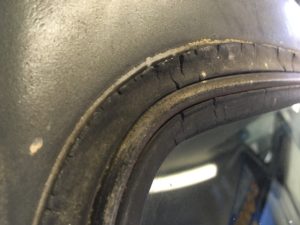
Bertha’s windshield gasket was badly cracked, just like Louie’s, but fortunately it wasn’t nearly as hard.
First, because Louie had sat outside for many years, its windshield gasket had turned hard as alligator skin, and even after cutting it off with a utility knife (a tendon-threatening operation), the bits of the gasket that remained were so hard that I had to scrape or sand them off. As it happened, I got a pass with this on Bertha; although her gasket was visibly shrunken and cracked, it cut easily with a knife, and came off relatively cleanly.
Second, once I removed Louie’s gasket, there was a little surface rust that had to be wire-brushed off, then neutralized, then the metal primed and painted. On Bertha, the situation was substantially worse: Once I cleaned the rust with a wire wheel on a drill and treated it with naval jelly, several rust holes opened up, ranging from pencil-point size to about half the diameter of an eraser. I posted photos of the rust holes online and proposed patching them with JB Weld SteelStik epoxy putty; the responses skewed to the usual cacophony of, “Do it once, do it right,” “If you don’t patch that with a welder, you’re an idiot,” etc.
A few folks, though, were sympathetic, pointing out that that’s thin metal to begin with; that with the rust formation it’s even thinner; that as soon as you touch a wire-feed welder to the thin metal, you’re likely to blow holes in it; and that it’s a narrow, curved section, so it’s going to be difficult to fabricate and weld in a patch.
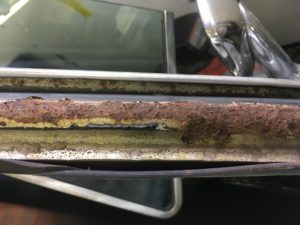

I felt that with all of Bertha’s body issues, it made little sense to concentrate on restoring six square inches around the windshield frame to perfection. I wound up using not SteelStick but POR-15 Patch seam-sealer and filler, a product that has the same rust-binding properties as POR-15 paint. It squeezes out of a tube and smears on like RTV, but dries rock-hard and is sandable. I patched the holes, leveled out some of the deeper pitted areas, sanded, then primed it using some gray rust-inhibiting primer I have that’s very similar to POR-15.
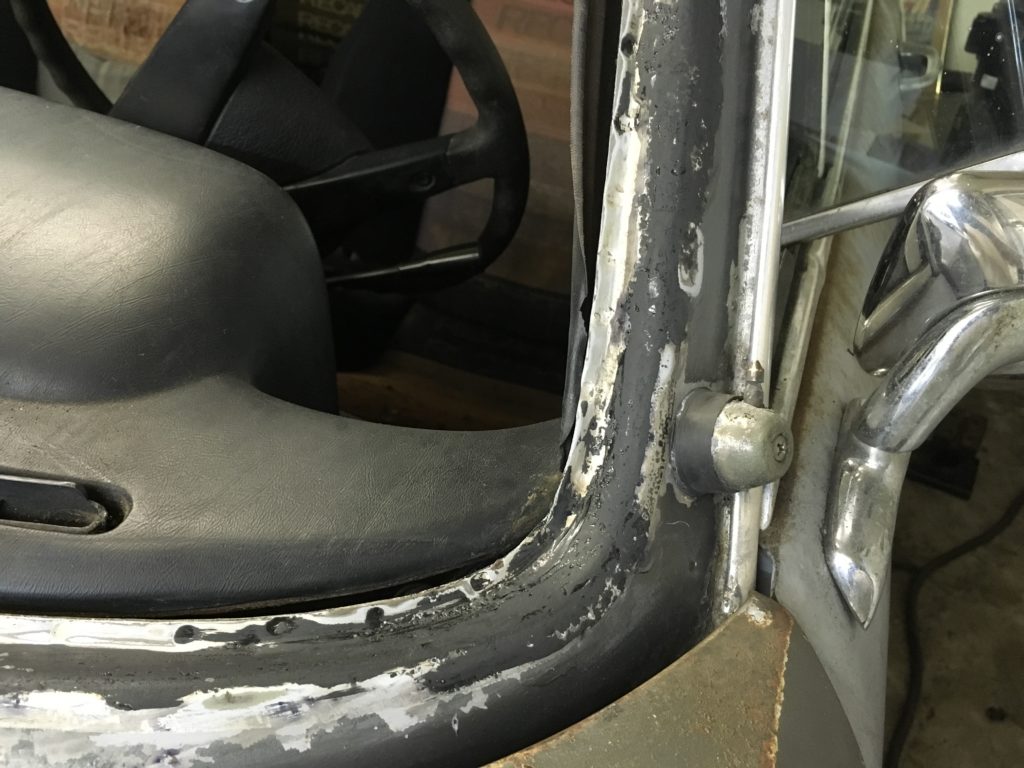
This is the result of using POR-15 Patch to fill in both the holes and the pitted areas, then sanding it level.
I chose to not paint over the primer. With the distressed-beyond-recognition condition of Bertha’s paint, there didn’t seem to be much reason to. After all, Bertha’s driver’s door had been in primer for 34 years. Plus, at some point prior to my ownership, Bertha had been repainted, and oddly, the color used wasn’t the original Polaris silver, but was closer to Battleship Gray. This color disparity was very evident when I removed the windshield gasket. If I ever repaint her—unlikely in the extreme; it would destroy my relationship with the car—I’d take her back to the original Polaris. But for now, with both Polaris and Battleship Gray plainly showing around the windshield frame, I simply added another shade of gray to the palette. It’s just another scar, another part of the story.
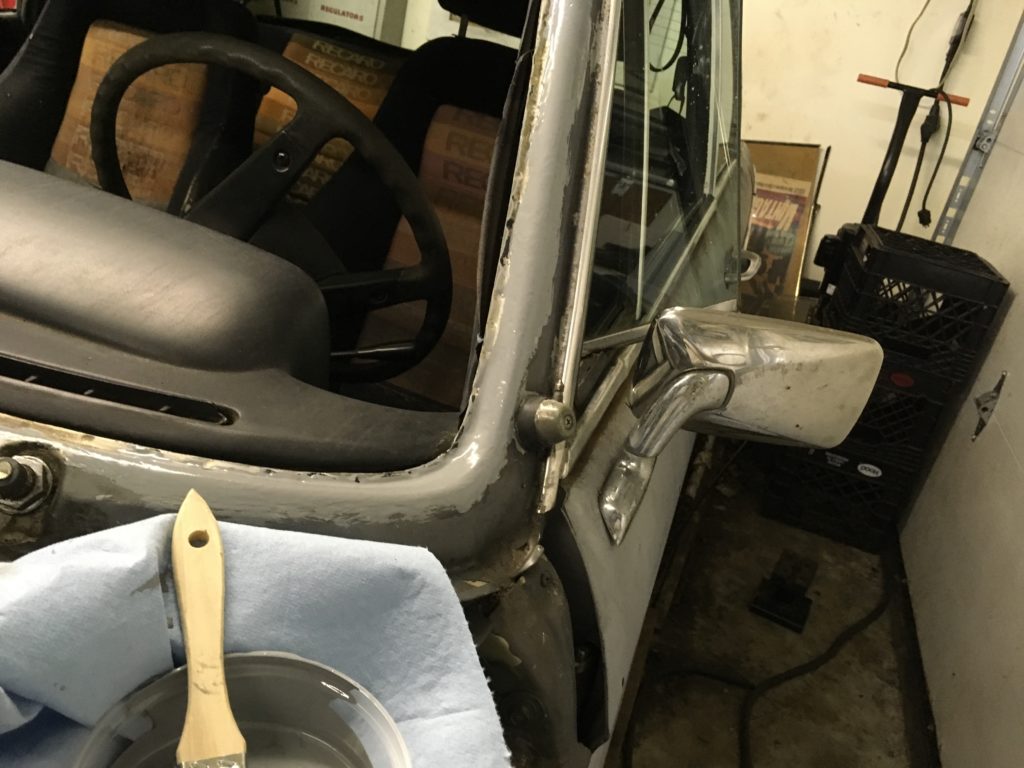
A fourth shade of gray goes on Bertha.
The third issue in the windshields-are-hell trifecta is the actual installation of the windshield and gasket, and we’ll cover that next week. Trust me: It was enough of a pain in the butt to deserve its own installment.—Rob Siegel
Rob’s new book, Just Needs a Recharge: The Hack MechanicTM Guide to Vintage Air Conditioning, is available here on Amazon. His previous book Ran When Parked is available here. Or you can order personally inscribed copies of all of his books through Rob’s website: www.robsiegel.com.

